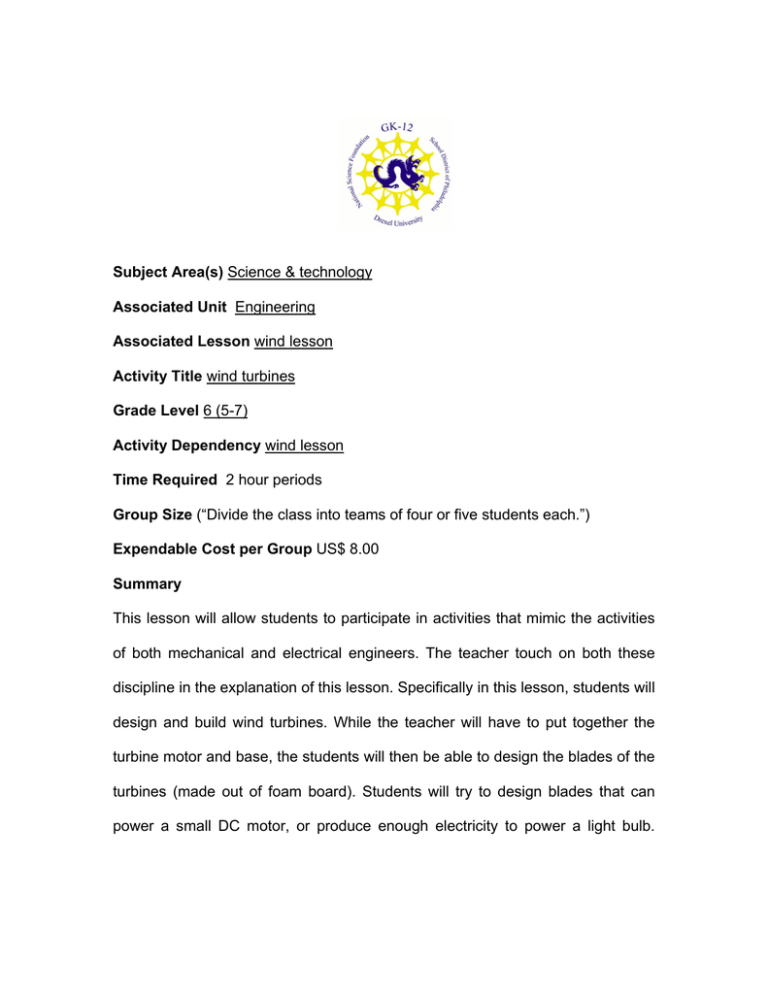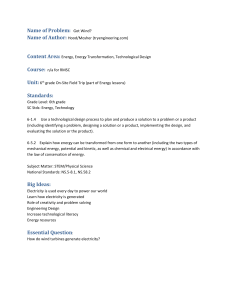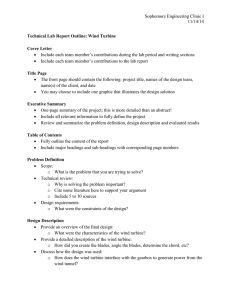Subject Area(s) Associated Unit Associated Lesson
advertisement

Subject Area(s) Science & technology Associated Unit Engineering Associated Lesson wind lesson Activity Title wind turbines Grade Level 6 (5-7) Activity Dependency wind lesson Time Required 2 hour periods Group Size (“Divide the class into teams of four or five students each.”) Expendable Cost per Group US$ 8.00 Summary This lesson will allow students to participate in activities that mimic the activities of both mechanical and electrical engineers. The teacher touch on both these discipline in the explanation of this lesson. Specifically in this lesson, students will design and build wind turbines. While the teacher will have to put together the turbine motor and base, the students will then be able to design the blades of the turbines (made out of foam board). Students will try to design blades that can power a small DC motor, or produce enough electricity to power a light bulb. Students should make the connection between the motor and light bulb with real worlds applications, for example electric production. Engineering Connection Electricity production often leads to air pollution. This is a result of burning fossil fuels to turn generators that produce electricity. Many engineers and scientists are investigating new forms of energy production. One form that shows potential is wind power. Wind power is already being used all over the worlds to produce electricity. More efficient wind turbines are being developed. This is what the students will do in today’s lesson. Keywords Electricity production, fossil fuels, turbines Educational Standards • Science: • Science: A.1, A.2, E.8, F.3, F.4, F.5, G.1, G.3, E.2, E.1 Pre-Req Knowledge Students should have limited knowledge of natural resources. Learning Objectives After this activity, students should be able to: • Describe the basic procedures engineers follow to solve problems • Describe the connection between the activity and real world applications of wind • Describe how using wind power can help decrease pollution. • Describe ways in which to improve their designs. Materials List 1 Basic PVC wind turbine kit from kidwind.org ($ 40 dollars) (it is possible to build this without the kit for around $15 dollar, if the teacher is handy) 8 3/8 dowels from home depot in 4 ft lengths 4 sheets of foam board. Hot glue gun Volt meter Small dc motor from radio shack Small light bulb from radio shack. Introduction / Motivation Electricity production often leads to air pollution. This is a result of burning fossil fuels to turn generators that produce electricity. Many engineers and scientists are investigating new forms of energy production. One form that shows potential is wind power. Wind power is already being used all over the worlds to produce electricity. More efficient wind turbines are being developed. This is what the students will do in today’s lesson. Students will design their own turbine blades with the end goal of producing the most electricity.Wrd Definition Procedure 1. The teacher should set up the basic PVC turbine kit before hand. 2. Have students brain storm for 30 mins about their design. They should be deciding on the length of their blades as well as the overall shape of their blades, and the number of blades. 3. After students have decided on their designs, they should then cut their blades out of the foam board paper and have them hot glued to the dowels. 4. The dowels should then be inserted into the hub of the turbine. 5. The wires that are attached to the motor should be plugged up to the voltmeter and the amount of voltage measured when wind is applied to the turbine via a fan. 6. Next attach the turbine wires to a dc motor, and then a light bulb to see if you can generate enough power to get them to turn on. Background Before the Activity • The teacher should gather materials for the wind turbine and construct it. • The teacher should also decide if students are capable of cutting the foam board or if it is a safety issue. • The teacher should also test dc motor to see if it will work with the minimum power generated from the turbine. Some motors will have different charesteristics. With the Students A lesson on wind energy should be taught. Safety Issues • Use eye protection (goggles or safety glasses) during this activity. • Care should be taken when testing turbines because blades could fly out during operation. Troubleshooting Tips Assessment The teacher should make the students write about the lesson in their logbooks answering the questions provided in the learning objective section of this lesson. Owner Rodney Johnson, Drexel University, GK 12 Contributors Kidwind.org







